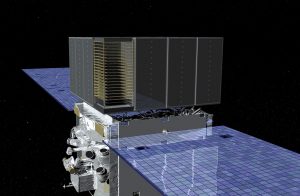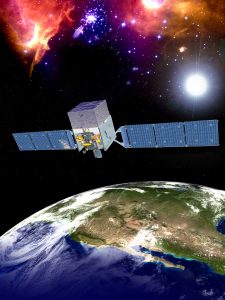It’s called PASS 8 and is the new software that reconstructs the interaction of gamma photons with detectors Fermi, the NASA satellite that Italy cooperates with Italian Space Agency (ASI), National Institute of Astrophysics (INAF) and National Institute of Nuclear Physics (INFN), dedicated to the study of gamma radiation of high and very high energy . Thanks to the start of PASS 8 , Fermi has been enhanced, and now the experiment is able to deliver unprecedented performance. In any astronomical instrument hardware it is as important as the software that is used to analyze the data collected. The groups that build instrumentation for telescopes anchored to the floor plan immediately upgrade their regular instruments. For example, you can change the sensors, using newer models, perhaps the largest and fastest to read, or you can change the alignment systems, cooling and so on. At the same time we must take action on software that must be adapted to the new sensor, the new demands of users, the new generations of computers … not to mention the astronomical new problems that may have occurred in the meantime.
 For the instruments in orbit, if you want to improve performance, you require action on software. Obviously the potential interest of a software upgrade is greater the longer the results depend on the software used. For an instrument that collects images, for example, a new board software can speed up the reading and the transmission, but hardly improves the intrinsic quality of the data. The situation is different for the Large Area Telescope (LAT) aboard the NASA mission. The data for each gamma ray must be reconstructed from the traces that the electron-positron pair (result of the interaction of gamma rays with matter detector) left in the tracker. Switch from the traces of the particles to the direction of arrival and the energy of the gamma photon is a complex task of reconstruction software that is integral to the Fermi telescope. It’s a software thought well before launch and that, while working very well, with time began to show some flaw. With the increase of statistics we have seen, in fact, that the program of reconstruction “lost” events at lower energies and the higher ones.
For the instruments in orbit, if you want to improve performance, you require action on software. Obviously the potential interest of a software upgrade is greater the longer the results depend on the software used. For an instrument that collects images, for example, a new board software can speed up the reading and the transmission, but hardly improves the intrinsic quality of the data. The situation is different for the Large Area Telescope (LAT) aboard the NASA mission. The data for each gamma ray must be reconstructed from the traces that the electron-positron pair (result of the interaction of gamma rays with matter detector) left in the tracker. Switch from the traces of the particles to the direction of arrival and the energy of the gamma photon is a complex task of reconstruction software that is integral to the Fermi telescope. It’s a software thought well before launch and that, while working very well, with time began to show some flaw. With the increase of statistics we have seen, in fact, that the program of reconstruction “lost” events at lower energies and the higher ones.
 To work the problem was not simply put a patch on the old software, you had to rethink everything from the beginning. “ It was therefore decided to proceed with the total rewrite of the software reconstruction of the events range ” explains Elizabeth Cavazzuti , in charge of cooperation for the Fermi ‘ Italian Space Agency . “ A difficult task that required the efforts of many heads for about four very intense years. Pass 8 has changed (for the better) the performance of the Fermi mission whose data were reanalyzed with all the new software. Seven and a half years since the launch LAT is now a more powerful tool “. The most important improvements were recorded for the lower energies (where, however, the angular resolution of the instrument is quite poor) and higher ones (where instead the angular resolution is better). For this reason the data PASS 8 were initially used to compile a catalog of sources detected by Fermi energies between 50 GeV and 2 TeV, an energy range that, until now, had been prerogative of telescopes on the ground range. Analyzing 61,000 gamma rays with energies above 50 GeV, Fermi revealed 360 sources, three quarters of which are related to active galaxies, while 11% are connected to the accelerated particles from pulsars or from supernova remnants. The remaining 14% of sources not associated with objects known at other wavelengths.
To work the problem was not simply put a patch on the old software, you had to rethink everything from the beginning. “ It was therefore decided to proceed with the total rewrite of the software reconstruction of the events range ” explains Elizabeth Cavazzuti , in charge of cooperation for the Fermi ‘ Italian Space Agency . “ A difficult task that required the efforts of many heads for about four very intense years. Pass 8 has changed (for the better) the performance of the Fermi mission whose data were reanalyzed with all the new software. Seven and a half years since the launch LAT is now a more powerful tool “. The most important improvements were recorded for the lower energies (where, however, the angular resolution of the instrument is quite poor) and higher ones (where instead the angular resolution is better). For this reason the data PASS 8 were initially used to compile a catalog of sources detected by Fermi energies between 50 GeV and 2 TeV, an energy range that, until now, had been prerogative of telescopes on the ground range. Analyzing 61,000 gamma rays with energies above 50 GeV, Fermi revealed 360 sources, three quarters of which are related to active galaxies, while 11% are connected to the accelerated particles from pulsars or from supernova remnants. The remaining 14% of sources not associated with objects known at other wavelengths.
 Comparing the new catalog with the compilation of the Fermi gamma-ray sources seen by ground, using special telescopes that use the ‘ Cherenkov effect , you immediately notice that Fermi sees more than twice the sources detected by telescopes on the ground range. “ The difference between Fermi LAT and Cherenkov telescopes – explains Patrizia Caraveo INAF responsible for the Fermi mission and board member of the project CTA (Cherenkov Telescope Array) – is all in the sky explored. Fermi has a large field of view (approximately two steradians) and, operating in scanning mode, covering the entire sky every three hours, the Cherenkov telescopes on the ground, however, have much smaller field of view (a few square degrees) and must point a certain direction, covering an area of the sky much more limited. Only 90 of the 360 springs in the catalog Fermi coincide with sources seen by telescopes on the ground (do not forget that many of the extragalactic gamma source are violently variable), showing that Fermi can act as a forerunner to report to telescopes on the ground the most interesting regions to study. PASS 8 raises a new synergy between gamma astronomy and space that anchored to the ground that will be of great benefit to the mini array of small telescopes Cherenkov that INAF build as a precursor to the Cherenkov Telescope Array “. “ The commitment of our team to Pass 8 results in many exciting research by Ferm ” notes Luca Latronico , program manager Fermi LAT for the INFN, in whose laboratories they were integrated all plotters silicon telescope and designed many of the algorithms of the new reconstruction software. “ The increase in sensitivity makes it possible to detect very weak springs, or significantly lower the minimum detectable flow limits, as in the case of dwarf galaxies, where the non-observation of gamma photons directly translates into a strong limit on the mass and the probability of annihilation of dark matter particles that dominates these systems “. “ The greater extent energy of comments – continues Latronico – now allows you to record on one side of 2 TeV electrons with enough efficiency to seek local sources, and photons of a few tens of MeV other , looking for gamma sources or polarized gamma-ray bursts coming from the edge of the Universe . “
Comparing the new catalog with the compilation of the Fermi gamma-ray sources seen by ground, using special telescopes that use the ‘ Cherenkov effect , you immediately notice that Fermi sees more than twice the sources detected by telescopes on the ground range. “ The difference between Fermi LAT and Cherenkov telescopes – explains Patrizia Caraveo INAF responsible for the Fermi mission and board member of the project CTA (Cherenkov Telescope Array) – is all in the sky explored. Fermi has a large field of view (approximately two steradians) and, operating in scanning mode, covering the entire sky every three hours, the Cherenkov telescopes on the ground, however, have much smaller field of view (a few square degrees) and must point a certain direction, covering an area of the sky much more limited. Only 90 of the 360 springs in the catalog Fermi coincide with sources seen by telescopes on the ground (do not forget that many of the extragalactic gamma source are violently variable), showing that Fermi can act as a forerunner to report to telescopes on the ground the most interesting regions to study. PASS 8 raises a new synergy between gamma astronomy and space that anchored to the ground that will be of great benefit to the mini array of small telescopes Cherenkov that INAF build as a precursor to the Cherenkov Telescope Array “. “ The commitment of our team to Pass 8 results in many exciting research by Ferm ” notes Luca Latronico , program manager Fermi LAT for the INFN, in whose laboratories they were integrated all plotters silicon telescope and designed many of the algorithms of the new reconstruction software. “ The increase in sensitivity makes it possible to detect very weak springs, or significantly lower the minimum detectable flow limits, as in the case of dwarf galaxies, where the non-observation of gamma photons directly translates into a strong limit on the mass and the probability of annihilation of dark matter particles that dominates these systems “. “ The greater extent energy of comments – continues Latronico – now allows you to record on one side of 2 TeV electrons with enough efficiency to seek local sources, and photons of a few tens of MeV other , looking for gamma sources or polarized gamma-ray bursts coming from the edge of the Universe . “
‘); document.write (”);
No comments:
Post a Comment